Golf Scoring: Key Concepts for Beginners and Enthusiasts
Discover how golf scoring works with our ultimate guide! Perfect for beginners and enthusiasts—learn stroke play, match play, handicaps, and more.
GOLF RULES
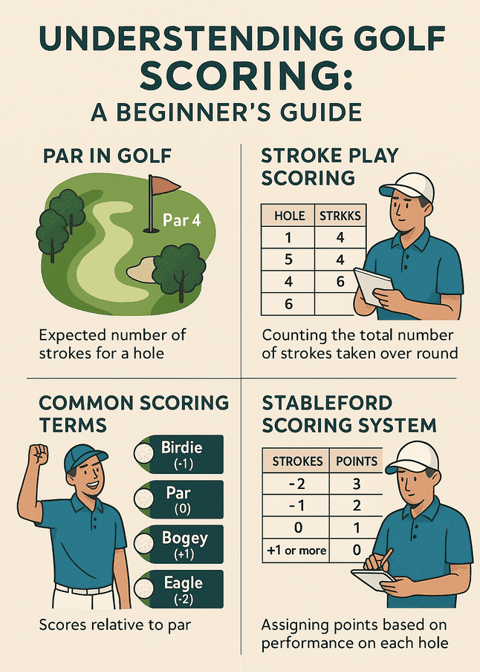

Introduction to Golf Scoring
Golf is a sport that blends precision, strategy, and sportsmanship, captivating players across golf courses worldwide. For beginners, terms like double bogey, hole in one, and Stableford scoring can seem daunting, while enthusiasts seek deeper insights to refine their game. Understanding golf scoring is crucial for enjoying a round of golf, whether at River’s Edge Golf Course or planning a golf trip. This guide explores scoring systems, essential golf terms, and golf etiquette, equipping you to track Golf Scores confidently and enhance your experience on the tee boxes.
A Brief History of Golf Scoring




The modern game of golf originated in 15th-century Scotland, with the 18-hole round standardized at St. Andrews in 1764 (Golf History). Scoring terms like bogey emerged in the 1890s, inspired by a Scottish term for a goblin, representing the ideal score for a hole. The Royal and Ancient Golf Club of St. Andrews (R&A) and the Scottish Golf Union have since shaped global scoring rules, ensuring fairness across golf courses. This historical context enriches our appreciation of golf scoring terms and their evolution.
Understanding Par and Scoring Terms
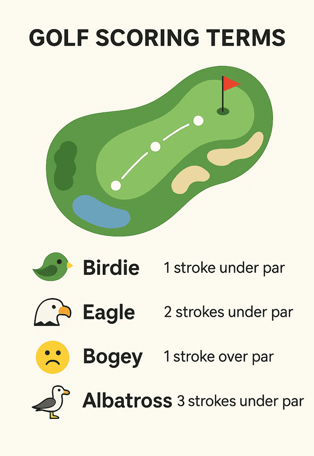

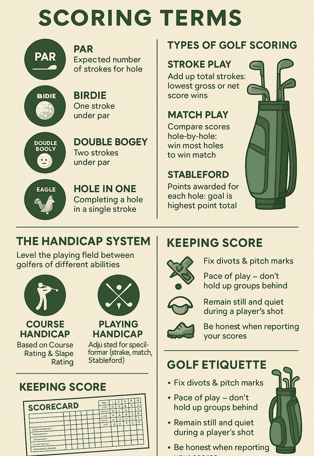

At the core of golf scoring is par, the expected number of strokes an expert golfer takes to complete a hole, typically ranging from 3 to 5. Here’s a detailed look at key terms:
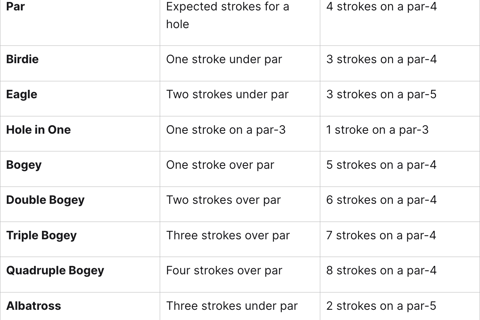

A hole in one is a rare feat, with odds of 12,500:1 for amateurs (Hole in One Facts). Famous examples include Tiger Woods’ 1997 ace at TPC Scottsdale’s 16th hole. Albatross and condor are even rarer, with only a few condors recorded in PGA history, typically on par-5 holes with a strategic cut-off.
Types of Golf Scoring Formats
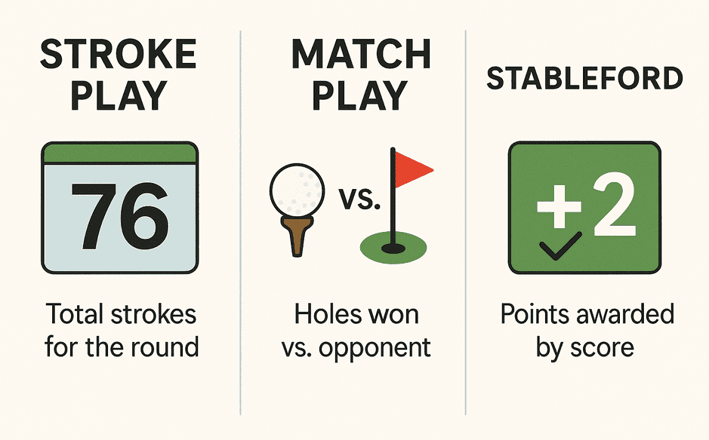

Golf offers diverse scoring formats, each with unique strategies:
Stroke Play
The most common format, used in tournaments covered by Golf Digest, counts every stroke toward the gross score—the total strokes taken. The net score adjusts the gross score by subtracting handicap strokes, allowing fair competition across skill levels. For example, a player with a course handicap of 10 subtracts 10 strokes from their gross score.
Match Play
In match play, players compete hole-by-hole, winning a hole by taking fewer strokes. This format, popular in events like the Ryder Cup, emphasizes strategy over total strokes. The R&A endorses match play for its competitive intensity, often using handicap strokes to balance skill differences.
Stableford Scoring
The Stableford system awards points based on performance per hole:
0 points: Double bogey or worse
1 point: Bogey
2 points: Par
3 points: Birdie
4+ points: Eagle or better
This format, common at River’s Edge Golf Course, rewards aggressive play and minimizes the impact of poor holes, making it ideal for club events.
The Handicap System: Leveling the Playing Field
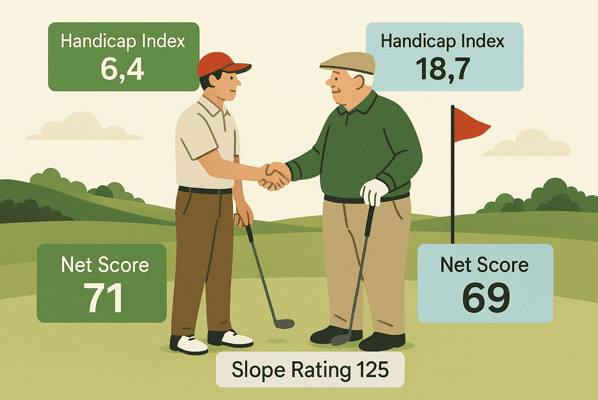

The Golf Handicap system ensures fair competition by adjusting scores based on player ability and course difficulty. The Handicap Index is calculated using the best 8 of a player’s most recent 20 Score Differentials, adjusted for Course Rating and Slope Rating (USGA Handicap). The Course Handicap reflects the difficulty of a specific course, while the Playing Handicap adjusts for competition formats. For example, a player with a Handicap Index of 15 on a course with a Slope Rating of 130 might have a Course Handicap of 17, allowing them to subtract 17 strokes for their net score.
The Role of Golf Gear in Scoring


Your golf gear significantly impacts Golf Scores:
Golf Clubs: Drivers maximize distance off the tee, while wedges excel in short-game precision. Properly fitted golf clubs reduce mishits, preventing double bogeys.
Golf Balls: Two-piece balls offer distance for beginners, while multi-layer balls provide spin control for enthusiasts, improving accuracy.
Golf Shoes: Spiked golf shoes ensure stability during the golf swing, reducing errors.
Golf Bag and Cart: A well-organized golf bag and golf cart streamline gear transport, keeping you focused.
Golf App: Apps like 18Birdies track scores, provide GPS, and calculate handicaps in real-time.
How to Keep Score: Gross vs. Net
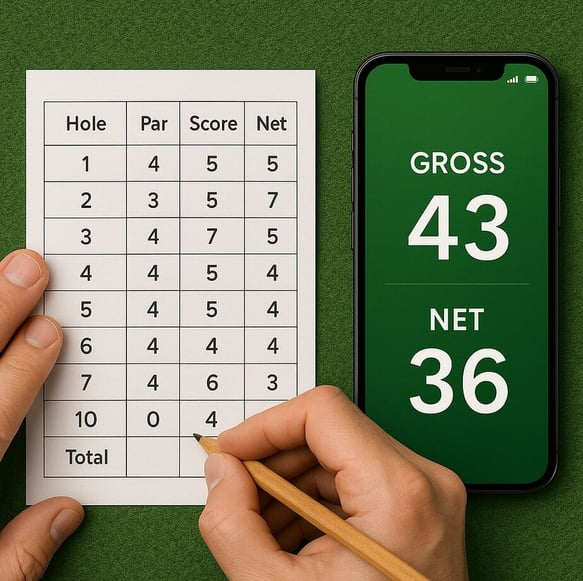

A Golf scorecard records each hole’s par, yardage, and strokes taken. Here’s how to use it:
Record strokes per hole in the designated column.
Tally the gross score at the end of the round.
Subtract handicap strokes to calculate the net score.
Verify scores with playing partners before signing the scorecard.
For example, a player scoring 85 (gross) with a Course Handicap of 12 has a net score of 73. Digital golf apps simplify this process with automatic calculations.
Golf Etiquette While Scoring


Golf etiquette enhances the experience for all players:
Honesty: Accurately record strokes, including penalties.
Verification: Confirm scores with partners before signing the scorecard.
Course Care: Repair divots, fix pitch marks, and rake bunkers.
Pace of Play: Keep up with the group ahead, even after a triple bogey.
Respect: Stay quiet during others’ shots and maintain composure.
These practices, upheld by organizations like the Scottish Golf Union, ensure integrity and enjoyment.
Common Scoring Mistakes and How to Avoid Them
Avoid these pitfalls to maintain accurate Golf Scores:
Ignoring Penalties: Lost balls or out-of-bounds shots add strokes. Always account for them.
Missing Whiffs: A swing that misses the ball counts as a stroke.
Gross vs. Net Confusion: Clarify whether the competition uses gross score or net score.
Scorecard Errors: Double-check entries after each hole.
Using a golf app or having a partner verify scores can prevent mistakes.
Modern Scoring Tools
Technology transforms golf scoring:
Golf Apps: Apps like GHIN offer GPS, digital score cards, and handicap tracking.
Electronic Scorecards: These are used in tournaments, and they reduce errors.
Real-Time Leaderboards: Featured in Golf Digest, they enhance competitive play.
These tools ensure accuracy and enrich the experience at golf courses.
Famous Golf Holes and Their Impact on Scoring


Iconic holes challenge players and influence Golf Scores:
17th at St. Andrews (Road Hole): A par-4 with a blind tee shot and deep bunker, it demands precision (Famous Golf Holes).
12th at Augusta National (Golden Bell): A par-3 with Rae’s Creek and swirling winds, it’s a scoring decider in the Masters.
9th at River’s Edge Golf Course: Known as “Arnie’s Revenge,” this hole’s unique design tests strategy (River’s Edge).
Studying these holes helps golfers develop course management skills, reducing quadruple bogeys.
Golf Swing Techniques to Improve Scoring
A consistent golf swing lowers scores:
Alignment: Aim correctly to hit fairways, avoiding bogeys.
Tempo: Maintain a smooth rhythm for better contact.
Short Game: Practice chipping and putting, as most strokes occur near the green.
Drills like the “gate drill” for putting improve accuracy, directly impacting Golf Scores.
Mental Aspects of Golf Scoring


The mental game influences performance:
Stay Positive: Accept double bogeys and focus on the next shot.
Pre-Shot Routine: Develop a consistent routine to maintain focus.
Manage Pressure: Breathe deeply to stay calm on critical holes.
These strategies, endorsed by professionals in Golf Digest, help avoid triple bogeys.
Planning a Golf Trip with Confidence
A successful golf trip enhances your scoring experience:
Research Courses: Check Course Rating and Slope Rating to match your skill level. River’s Edge Golf Course offers varied tee boxes for all players.
Pack Essentials: Include golf clubs, golf balls, golf shoes, and a golf bag.
Use Technology: Download a golf app for GPS and scoring.
Understand Rules: Some courses follow R&A guidelines, others USGA.
Practice Etiquette: Respect local golf etiquette to blend in.
Booking tee times at courses like River’s Edge ensures a memorable trip.
Conclusion
Mastering golf scoring—from gross score to net score, match play to Stableford system—empowers you to enjoy every round of golf. Pair this knowledge with quality golf gear, impeccable golf etiquette, and tools like golf apps to elevate your game. Whether navigating River’s Edge Golf Course or dreaming of St. Andrews, practice your golf swing, track scores accurately, and embrace every challenge, from a hole-in-one to a quadruple bogey. Golf is a journey of skill and strategy—enjoy every hole!
FAQ
How does the Stableford scoring system work?
The Stableford scoring system, developed by Dr. Frank Stableford in 1898, awards points based on a player’s score relative to par on each hole, adjusted for their course handicap. Unlike stroke play, the goal is to achieve the highest point total, encouraging aggressive play and minimizing the impact of poor holes (Bunkered Stableford).
How do I keep score in golf?
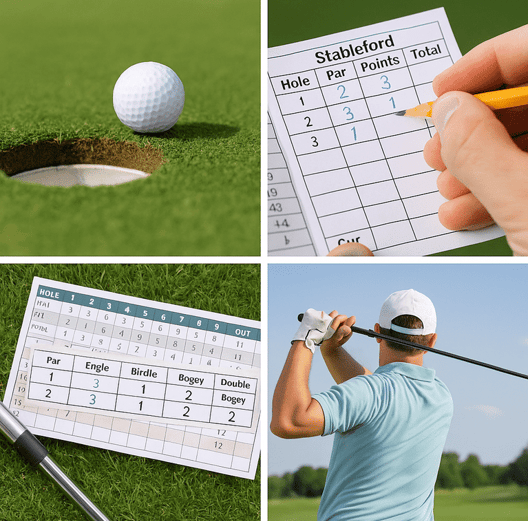

Keeping score involves recording strokes on a Golf scorecard for each hole. In stroke play, sum the strokes for the gross score and subtract handicap strokes for the net score. In match play, track holes won or halved. For Stableford scoring, convert scores to points and sum them. Use a golf app for real-time tracking or verify scores manually with partners to avoid errors. Always include penalty strokes, such as for lost golf balls, and confirm scores before signing the scorecard.
What is the importance of Course Rating and Slope Rating?
Course Rating represents the expected score for a scratch golfer, while Slope Rating measures relative difficulty for a bogey golfer compared to a scratch golfer (standard slope is 113). These metrics, found on golf course scorecards, adjust a player’s Course Handicap to ensure fair competition. For example, a high Slope Rating increases the handicap strokes allocated, impacting the net score (USGA Course Rating).
How does the handicap system allow players of different levels to compete?
The Golf Handicap system adjusts scores to enable fair competition. A higher-handicap player receives more handicap strokes, subtracted from their gross score to calculate the net score. For example, a player with a Course Handicap of 20 scoring 92 has a net score of 72, competing evenly with a scratch golfer scoring 72 gross. This system, governed by the Scottish Golf Union and R&A, fosters inclusivity.
How do tee boxes affect golf scoring?
Tee boxes determine a hole’s starting point and difficulty. Golf courses offer multiple tee options (e.g., championship, regular, forward) to match skill levels. Playing from the tee boxes too advanced can increase scores, leading to bogeys or worse. Choosing appropriate tees, as advised at River’s Edge Golf Course, ensures a fair and enjoyable game, impacting Golf Scores positively.
What are some common mistakes beginners make in scoring?
Beginners often err by:
Omitting penalty strokes (e.g., for lost balls or out-of-bounds).
Missing “whiffs” (swings that miss the ball count as strokes).
Confusing gross score and net score in handicap events.
Incorrectly marking the scorecard, leading to disqualification.
Cross-check scores with partners or use a golf app to ensure accuracy (Performance Golf).
